Check valve and its working principle
What is check valve?
Check valve refers to a valve whose opening and closing parts are circular discs and rely on its own weight and medium pressure to generate actions to block the back flow of the medium. It is an automatic valve, also called check valve, one-way valve, return valve or isolation valve. The movement of the disc is divided into lift check valve and swing check valve. The lift check valve is similar in structure to the stop valve, but lacks the valve stem to drive the valve disc. The medium flows in from the inlet end (lower side) and flows out from the outlet end (upper side). When the inlet pressure is greater than the sum of the weight of the disc and its flow resistance, the valve is opened. On the contrary, the valve is closed when the medium flows back. The swing check valve has a disc that is incline

tilting disc check valve body (2)
d and can rotate around the axis, and its working principle is similar to that of the lift check valve. The check valve is often used as the bottom valve of the pumping device to prevent the backflow of water. The combination of check valve and stop valve can play a role of safety isolation. The disadvantage is that the resistance is large and the sealing performance is poor when closed.
Working principle of check valve:
Check valves can also be used to supply pipelines for auxiliary systems whose pressure may rise above the system pressure. Check valves can be divided into swing check valves (rotating according to the center of gravity) and lift check valves (moving along the axis).
The function of this type of valve is to only allow the medium to flow in one direction and prevent the flow in the opposite direction. Usually this kind of valve works automatically. Under the action of the fluid pressure flowing in one direction, the valve flap opens; when the fluid flows in the opposite direction, the fluid pressure and the self-coincidence of the valve flap act on the valve seat, thereby cutting off the flow.
Among them, check valves belong to this type of valve, which includes swing check valves and lift check valves. The swing check valve has a hinge mechanism and a valve flap like a door that rests freely on the inclined valve seat surface. In order to ensure that the valve clack can reach the proper position of the valve seat surface every time, the valve clack is designed in a hinge mechanism so that the valve clack has enough space for rotation and makes the valve clack truly and comprehensively contact the valve seat. The valve clack can be made of metal, or inlaid with leather, rubber, or synthetic covering, depending on the performance requirements. When the swing check valve is fully opened, the fluid pressure is almost unimpeded, so the pressure drop through the valve is relatively small. The disc of the lift check valve is located on the sealing surface of the valve seat on the valve body. Except that the disc can be raised and lowered freely, the rest of the valve is like a shut-off valve. The fluid pressure lifts the disc from the seat sealing surface, and the backflow of the medium causes the disc to fall back to the seat and cut off the flow. According to the conditions of use, the valve disc can be an all-metal structure, or it can be in the form of a rubber pad or a rubber ring inlaid on the disc holder. Like a shut-off valve, the passage of fluid through the lift check valve is also narrow, so the pressure drop through the lift check valve is larger than the swing check valve, and the flow rate of the swing check valve is restricted.
Related news /products:
All types of check valve and its structures;
Introduction of cast steel lift swing check valve;
Classification of check valves;
Working principle diagram of lift check valve;

 tanghaivalve.com
tanghaivalve.com

 © Copyright 2020 Tianjin Tanghaidongyang Valve Co., Ltd. All Rights Reserved.
© Copyright 2020 Tianjin Tanghaidongyang Valve Co., Ltd. All Rights Reserved.